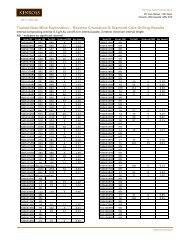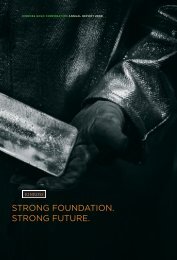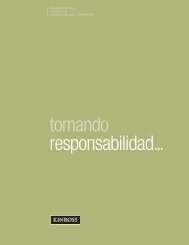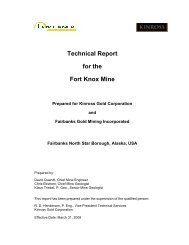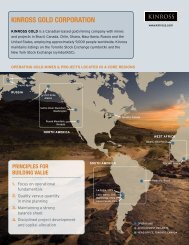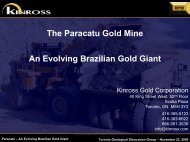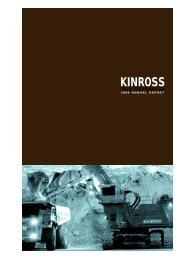Technical Report for the Maricunga Gold Mine - Kinross Gold
Technical Report for the Maricunga Gold Mine - Kinross Gold
Technical Report for the Maricunga Gold Mine - Kinross Gold
- No tags were found...
Create successful ePaper yourself
Turn your PDF publications into a flip-book with our unique Google optimized e-Paper software.
<strong>Kinross</strong> <strong>Gold</strong> Corporation<strong>Maricunga</strong> <strong>Mine</strong> <strong>Technical</strong> <strong>Report</strong>is cut by fine-grained matrix material that <strong>for</strong>ms clastic-like dikes. These are generally > 2cm in width. They may have been <strong>for</strong>med as “fluidized” material injected into fractures at <strong>the</strong>time of <strong>the</strong> <strong>for</strong>mation of <strong>the</strong> unit.8.2 PanchoThe gold mineralization at Pancho is also described as porphyry style mineralization. Itoccurs within a sequence of intermediate tuffs, porphyries and breccias that are <strong>the</strong> hostrocks to <strong>the</strong> gold mineralization. Lithological interpretation based on <strong>the</strong> recent 2006 drillprogram has identified six major lithologic units. These are from older to younger rocks:• Hornfels – They represent less than 5% of <strong>the</strong> total volume. They were identified atdepth in <strong>the</strong> Pancho porphyry system. They are present in a series of elongatedbodies, sub-horizontal and intercalated with intrusive breccias and dioritic porphyry.The hornfels are also characterized by widespread intense silicification.• Diorite Porphyry - Rocks hypabyssal that represent 60% of <strong>the</strong> volume of <strong>the</strong> Panchointrusive complex. It is <strong>the</strong> most frequent host of mineralized A, B and T veinlets.The diorite porphyry also shows signs of being intruded by a smaller intrusive phase.The porphyry displays obvious porphyry texture with 20 to 40 % phenocrysts.Phenocrysts alteration pattern include biotite or hornblende being completed alteredand replaced by assemblages of chlorite-quartz-sericite-magnetite-hematite. Atdepth <strong>the</strong> porphyry clearly shows potassic alteration.• Intrusive Breccias – The intrusive breccias represent approximately 15% of <strong>the</strong>volume of material in <strong>the</strong> Pancho complex. They are generally elongated and subhorizontal.These breccias are characterized by <strong>the</strong>ir fragments of dioritic porphyry.The fragments vary in size <strong>for</strong> mm to several cm within a matrix which is normallyfine-grained. The intrusive breccias are a significant host of gold mineralization withA, B, T veinlets.• Diorite Porphyry (2) - This diorite porphyry is defined as a small body identifiedbetween two drill sections and found at depths ranging from 300-400 meters. 400 m.In <strong>the</strong>ory, it intrudes <strong>the</strong> main porphyry but in turn is intruded by <strong>the</strong> PMI. It is verysimilar to <strong>the</strong> main porphyry body in terms of mineralogy, alteration andmineralization. The main difference observed is its primary biotite that is partiallyaltered into chlorite. It also has less veinlets than <strong>the</strong> main diorite porphyry.• Dioritic Post <strong>Mine</strong>ral Intrusive – The Post <strong>Mine</strong>ral Intrusive (PMI) identified at Panchois not a PMI in a strict sense as <strong>the</strong>re is some very low-grade mineralizationassociated with it.• Volcanic Breccias – Found in <strong>the</strong> upper portion of <strong>the</strong> deposit <strong>the</strong>y representapproximately 15 % of <strong>the</strong> volume of material explored to date at Pancho. Thevolcanic breccias are normally sub-horizontal and discordant with <strong>the</strong> o<strong>the</strong>r unitsdescribed.36



